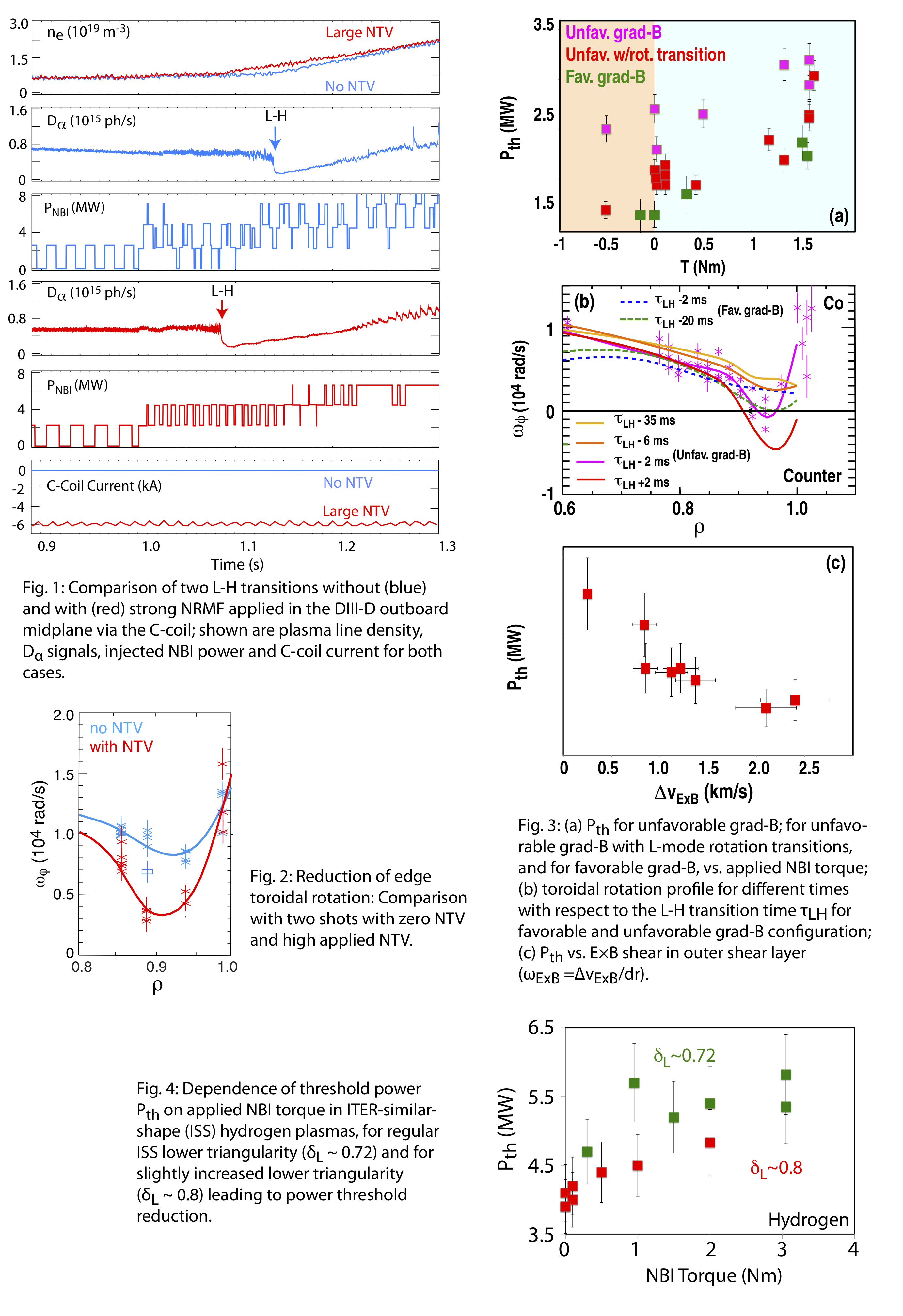Speaker
Description
Initial experimental evidence shows that the L-H transition power threshold P_th can be reduced via Neoclassical Toroidal Viscosity (NTV) associated with applied n=3 non-resonant magnetic fields (NRMF) [Figs. 1 and 2], and, independently, via a fast reduction or reversal of intrinsic edge toroidal (co)rotation [Fig. 3]. It is also demonstrated that a small/moderate increase in lower triangularity reduces P_th [Fig. 4]. These actuators are shown to enhance local E×B flow and E×B shear just inside the LCFS. Rotation reversals reduce the L-H transition power threshold with unfavorable grad-B drift direction to values similar to P_th in favorable configuration.
Techniques for reducing P_th, or mitigating its increase with applied magnetic perturbations are crucially important for ITER, particularly in view of marginal auxiliary power in hydrogen plasmas during the PFPO-1 campaign. Several approaches are demonstrated here that increase the L-mode E×B shear preceding the L-H transition, and potentially open up a path to reduce or mitigate P_th in burning plasma experiments. Control of L-mode edge shear flow is accomplished using either externally applied NRMF torque, or by changing the edge rotation boundary condition. In addition, P_th has been reduced via small plasma triangularity changes (within ITER-relevant margins).
Initial evidence shows that a large NRMF torque applied via the C-coil (1) can reduce P_th at low ion edge collisionality [ν_i*(ρ=0.95)~0.15] [Fig.1]. It is obvious from Fig. 1 that the NBI power required to access H-mode is reduced with applied NRMF. The power threshold (expressed approximately as P_th ~ P_NBI+P_OH-dW/dt where the Ohmic power P_OH and the time derivative of the stored energy W have been taken into account) is reduced by ~25% (from ~4.3 MW without NRMF to ~3.15 MW with applied NRMF/NTV). The core radiated power is not separately measured but is estimated to be smaller than 80 kW. This observation of a reduction in power threshold with NRMF differs fundamentally from the power threshold increase observed with applied Resonant Magnetic Perturbations (RMP) due to edge stochasticity and increased edge toroidal co-rotation (2). In contrast, CER measurements here show a substantial reduction of the L-mode edge toroidal (Carbon) co-rotation with applied NRMF/NTV just before the L-H transition, qualitatively consistent with the direction of the expected NTV counter-torque [Fig.2]. As a consequence, E×B flow shear near the LCFS is found to increase via increased radial shear in the toroidal rotation term in the radial ion momentum balance. The (partial) ITER 3-D coil set available during the PFPO-1 campaign can be used to generate large NTV in the edge plasma layer, favored by the low collisionality expected in the ITER L-mode edge.
We have also investigated in detail the effect of magnetic geometry on P_th, and attribute the increased L-H power threshold with unfavorable grad-B drift direction clearly to reduced E×B flow shear due to higher edge toroidal co-rotation [Fig. 3(a)]. The L-H power threshold is shown to decrease monotonically with increasing E×B shear in the outer L-mode shear layer near the LCFS (shown via NBI torque scan, Fig. 3c), and does not depend on shear in the inner shear layer.
However, it has been observed that spontaneous local rotation transitions increase E×B edge shear flow preceding the L-H transition in balanced/low torque ITER-similar shape (ISS) plasmas in DIII-D. Fig. 3(b) shows radial profiles of toroidal edge rotation approaching the L-H transition. The rotation reduction/ reversal commences locally near ρ=0.95; the layer of reduced rotation then expands radially over several ms, providing sufficient E×B flow shear to induce the L-H transition. As a result, P_th in ISS plasmas can be reduced to values similar to those observed with favorable grad-B drift direction [Fig. 3(a)]. The threshold reduction occurs over a range in NBI torque but is most effective for balanced torque or with low counter-Ip torque. Reversal/ reduction of intrinsic edge co-rotation appears to be triggered by transient increases in edge power flow (via sawteeth crashes or radial transport avalanches).
In ISS plasmas, increasing the lower triangularity by ~12% results in a clear reduction in L-H power threshold (by ~15%, shown here for hydrogen ISS plasmas (Fig. 4). A smaller data set in deuterium plasmas also demonstrates a ~10-12% reduction of P_LH at increased triangularity at low torque (≤ ±0.2 Nm). In the higher triangularity shape the outer divertor strike point was moved slightly further away from the lower divertor cryopump, which could also have affected divertor neutral pressure.
This work was supported by the US Department of Energy under DE-FG02-08ER549841,
DE-AC05-00OR227252,DE-FG02-08ER 549993, DE-FC02-04ER546985,DE-FG02-07ER549176,
and DE-AC02-09CH114667.
(1) K.H. Burrell et al., Nucl. Fusion 53 (2013) 073038.
(2) L. Schmitz et al., Nucl. Fusion 58 (2019) 126010.

| Affiliation | University of California Los Angeles |
|---|---|
| Country or International Organization | United States |
